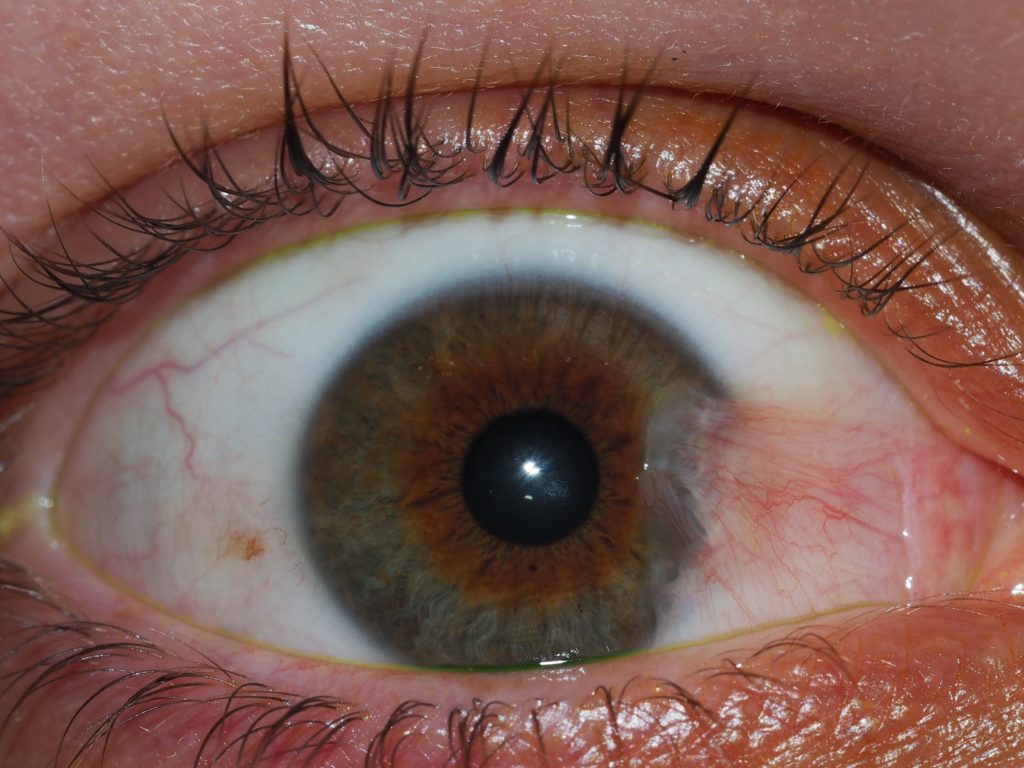Pterygium

Pterygium is a raised, fleshy, triangular-shaped growth of your eye’s conjunctiva onto the cornea.
Your conjunctiva is the clear membrane that covers the white of your eye.
The conjunctiva normally ends at the clear part of your eye, the cornea.
It grows from either corner of your eye, but usually more often from the corner closest to your nose.
Pterygium can affect one or both of your eyes.
Long-term exposure to UV light is the main cause.
Your eyes may be red, swollen and irritated in mild cases.
If pterygium grows, your vision may be blocked or blurred.
Treatments include symptom-relieving eye drops and ointment to surgery if your vision is affected or for cosmetic purpose.
Is pterygium a serious condition?
Pterygium is not cancer. However, it can grow large enough to cover part of your cornea (the clear dome that covers your pupil and iris). When this happens, it can affect your vision.
How long does pterygium last?
Pterygium can grow and spread slowly throughout your life or it may stop growing at some point.
What are the causes of pterygium?
It’s thought to be caused by:
Long-term exposure to the sun’s ultraviolet (UV) light (most common cause).
Eye irritation from hot and dry weather, wind and dust.
What are the symptoms of pterygium?
Early symptoms include:
A slightly raised pink growth on your eye.
Redness of eyes.
Itching,burning and dryness in eyes
Feeling like you have sand or grit is in your eye.
Watering of eyes
Late
symptoms include:
Increase in the size and spread of the lesion.
An unpleasant appearance of your eye due to the size of the lesion.
Blurred vision or double vision.
How is pterygium diagnosed?
Ophthalmologist can diagnose pterygium with a slit lamp. A slip lamp is a type of microscope that focuses a narrow (a “slit”) line of bright light on your eye. It helps your provider look at the front and inside of your eye. A slit lamp exam is a normal part of an eye exam.
Eye doctor may also take pictures of your eye to track changes in the growth of pterygium over time.
Management and Treatment
How is pterygium treated?
If your symptoms don’t cause discomfort or interfere with your vision, you probably don’t need treatment.
When there is symptoms,ophthalmologist might prescribe you the following medications:
Lubricating (Artificial tears) eye drops
Decongestant eye drops
Steroid eye drops
This medication is prescribed based on severity of symptoms
When might surgery be needed?
You may need surgery if:
Eye drops and eye ointments aren’t relieving your symptoms.
The pterygium grows so large that it blocks your vision or pulls on your cornea and changes its curve, causing astigmatism. Astigmatism can blur your vision.
Cosmetic:The way your eye looks is not acceptable to you.
What’s involved in pterygium surgery?
There are several surgical strategies. They include:
Removing only the pterygium.
Removing the pterygium and placing a sheet of “amniotic membrane” over the affected area.
Removing the pterygium and covering the affected area with a healthy piece of conjunctiva (autograft surgery) by suturing or glue. The healthy conjunctiva is usually taken from part of conjunctiva which is covered by upper eyelid. This procedure is best for preventing the return of pterygium.
What can I expect during recovery after surgery?
Eye patch is given for one day.
Instillation of prescribed eye drops as per doctor’s advice.
You might feel little watering and foreign body sensation for initial few days.
You can return to your normal daily activities in a few days.
Prevention
What can I do to lower my risk of a pterygium?
You can lower your risk of developing pterygium, slow its growth if you have one, or help prevent its return after surgery if you:
Wear sunglasses or a wide-brimmed hat when you’re in the sun to protect your eyes from ultraviolet light. Sunglasses should stop of both ultraviolet A and ultraviolet B rays. Wear them even on cloudy days.
Use artificial tears to keep your eyes moist, especially if you live in a dry climate.
Can pterygium cause blindness?
Pterygium can block or blur your vision if it continues to grow across your cornea.
Sometimes pterygium can scar your cornea, but this is rare.
It’s technically possible but rare that pterygium would result in blindness. Cases are usually minor or treated with medication or surgery if needed.
Does pterygium go away on its own?
It won’t go away on its own.
What’s the difference between pterygium and a cataract?
Pterygium is an overgrowth of the conjunctiva tissue itself.
Conjunctiva — the clear membrane that covers the entire front of your eye.
A cataract is a clouding of the lens of eye.
Lens is behind your iris (colored part of your eye).

